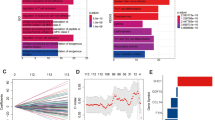Abstract
Interleukin-35 (IL-35) has recently been implicated in tumor immunity. The aim of this study was to explore the clinical role of plasma IL-35 in patients with non-small cell lung cancer (NSCLC). Plasma collected from 106 patients with NSCLC cases and 78 healthy controls (HC) were subjected to IL-35 enzyme-linked immunosorbent assay (ELISA) and relationships between plasma IL-35 levels and clinical characteristics were evaluated. The correlation of IL-35 and overall survival was analyzed using Kaplan–Meier method. The prognostic value of IL-35 was tested using univariate and multivariate analysis. Circulating IL-35 levels were significantly higher in the NSCLC group in comparison with the HC group (21.37 ± 11.55 pg/ml vs. 10.09 ± 5.32 pg/ml, p < 0.001). Correlation analysis by subgroup indicated that plasma IL-35 correlated positively with tumor TNM stage (p < 0.001) and lymph node metastases (p < 0.0001). Using a cutoff level of 20.26 pg/ml (median value), IL-35 showed an inverse correlation with overall survival. Univariate and multivariate analysis indicated that plasma IL-35 was an independent prognostic factor for NSCLC patients. Circulating IL-35 in NSCLC patients significantly increased. IL-35 is a promising potential biomarker in prognostication of clinical outcome of NSCLC patients and the regulation of IL-35 expression may provide a new target for the treatment of NSCLC patients.



Similar content being viewed by others
References
Jemal A, Bray F, Center MM, Ferlay J, Ward E, Forman D. Global cancer statistics. CA Canc J Clin. 2011;61(2):69–90. doi:10.3322/caac.20107.
Pathak AK, Bhutani M, Mohan A, Guleria R, Bal S, Kochupillai V. Non small cell lung cancer (NSCLC): current status and future prospects. Indian J Chest Dis Allied Sci. 2004;46(3):191–203.
Heist RS, Engelman JA. SnapShot: non-small cell lung cancer. Canc Cell. 2012;21(3):448.e2. doi:10.1016/j.ccr.2012.03.007.
Paesmans M, Sculier JP, Libert P, Bureau G, Dabouis G, Thiriaux J, et al. Prognostic factors for survival in advanced non-small-cell lung cancer: univariate and multivariate analyses including recursive partitioning and amalgamation algorithms in 1,052 patients. The European lung cancer working party. J Clin Oncol Offic J Am Soc Clin Oncol. 1995;13(5):1221–30.
Collison LW, Workman CJ, Kuo TT, Boyd K, Wang Y, Vignali KM, et al. The inhibitory cytokine IL-35 contributes to regulatory T-cell function. Nature. 2007;450(7169):566–U19. doi:10.1038/nature06306.
Devergne O, Birkenbach M, Kieff E. Epstein-Barr virus-induced gene 3 and the p35 subunit of interleukin 12 form a novel heterodimeric hematopoietin. Proc Natl Acad Sci USA. 1997;94(22):12041–6. doi:10.1073/pnas.94.22.12041.
Niedbala W, Wei XQ, Cai B, Hueber AJ, Leung BP, McInnes IB, et al. IL-35 is a novel cytokine with therapeutic effects against collagen-induced arthritis through the expansion of regulatory T cells and suppression of Th17 cells. Eur J Immunol. 2007;37(11):3021–9. doi:10.1002/eji.2007378101.
Collison LW, Chaturvedi V, Henderson AL, Giacomin PR, Guy C, Bankoti J, et al. IL-35-mediated induction of a potent regulatory T cell population. Nat Immunol. 2010;11(12):1093–U97. doi:10.1038/ni.1952.
Wang ZH, Liu JQ, Liu ZZ, Shen RL, Zhang GQ, Xu JP, et al. Tumor-derived IL-35 promotes tumor growth by enhancing myeloid cell accumulation and angiogenesis. J Immunol. 2013;190(5):2415–23. doi:10.4049/jimmunol.1202535.
Shen P, Roch T, Lampropoulou V, O’Connor RA, Stervbo U, Hilgenberg E, et al. IL-35-producing B cells are critical regulators of immunity during autoimmune and infectious diseases. Nature. 2014;507(7492):366–70. doi:10.1038/nature12979.
Dunn GP, Old LJ, Schreiber RD. The immunobiology of cancer immunosurveillance and immunoediting. Immunity. 2004;21(2):137–48. doi:10.1016/j.immuni.2004.07.017.
Devergne O, Coulomb-L’Hermine A, Capel F, Moussa M, Capron F. Expression of Epstein-Barr virus-induced gene 3, an interleukin-12 p40-related molecule, throughout human pregnancy: involvement of syncytiotrophoblasts and extravillous trophoblasts. Am J Pathol. 2001;159(5):1763–76. doi:10.1016/s0002-9440(10)63023-4.
Poleganov MA, Bachmann M, Pfeilschifter J, Muhl H. Genome-wide analysis displays marked induction of EBI3/IL-27B in IL-18-activated AML-derived KG1 cells: critical role of two kappaB binding sites in the human EBI3 promotor. Mol Immunol. 2008;45(10):2869–80. doi:10.1016/j.molimm.2008.01.021.
Niedobitek G, Pazolt D, Teichmann M, Devergne O. Frequent expression of the Epstein-Barr virus (EBV)-induced gene, EBI3, an IL-12 p40-related cytokine, in Hodgkin and Reed-Sternberg cells. J Pathol. 2002;198(3):310–6. doi:10.1002/path.1217.
Nishino R, Takano A, Oshita H, Ishikawa N, Akiyama H, Ito H, et al. Identification of Epstein-Barr virus-induced gene 3 as a novel plasma and tissue biomarker and a therapeutic target for lung cancer. Clin Cancer Res. 2011;17(19):6272–86. doi:10.1158/1078-0432.ccr-11-0060.
Jin P, Ren H, Sun W, Xin W, Zhang H, Hao JH. Circulating IL-35 in pancreatic ductal adenocarcinoma patients. Hum Immunol. 2014;75(1):29–33. doi:10.1016/j.humimm.2013.09.018.
Zeng JC, Zhang Z, Li TY, Liang YF, Wang HM, Bao JJ, et al. Assessing the role of IL-35 in colorectal cancer progression and prognosis. Int J Clin Exp Pathol. 2013;6(9):1806–16.
Wu H, Li P, Shao N, Ma J, Ji M, Sun X, et al. Aberrant expression of Treg-associated cytokine IL-35 along with IL-10 and TGF-beta in acute myeloid leukemia. Oncol Lett. 2012;3(5):1119–23. doi:10.3892/ol.2012.614.
Ettinger DS, Akerley W, Borghaei H, Chang AC, Cheney RT, Chirieac LR, et al. Non-small cell lung cancer, version 2.2013. J Natl Compr Canc Netw. 2013;11(6):645–53. quiz 53.
Kochetkova I, Golden S, Holderness K, Callis G, Pascual DW. IL-35 stimulation of CD39+ regulatory T cells confers protection against collagen II-induced arthritis via the production of IL-10. J Immunol. 2010;184(12):7144–53. doi:10.4049/jimmunol.0902739.
Long J, Zhang XL, Wen MJ, Kong QL, Lv Z, An YQ, et al. IL-35 over-expression increases apoptosis sensitivity and suppresses cell growth in human cancer cells. Biochem Biophys Res Commun. 2013;430(1):364–9. doi:10.1016/j.bbrc.2012.11.004.
Acknowledgments
This study was supported by grants from the Ministry of Science and Technology of China (973 projects) (No. 2012CB917104) and the National Natural Science Foundation of China (Nos. 81172853 and 81201605), Shanghai Municipal Commission of Health and Family Planning (No. XYQ2011040).
Conflicts of interest
None
Author information
Authors and Affiliations
Corresponding authors
Additional information
Xiaobin Gu and Tian Tian contributed equally to this work as first authors.
Rights and permissions
About this article
Cite this article
Gu, X., Tian, T., Zhang, B. et al. Elevated plasma interleukin-35 levels predict poor prognosis in patients with non-small cell lung cancer. Tumor Biol. 36, 2651–2656 (2015). https://doi.org/10.1007/s13277-014-2887-8
Received:
Accepted:
Published:
Issue Date:
DOI: https://doi.org/10.1007/s13277-014-2887-8




